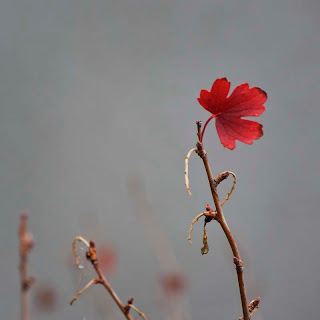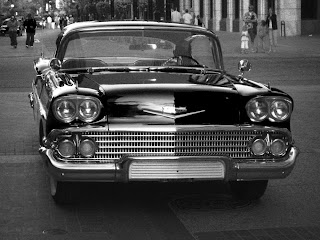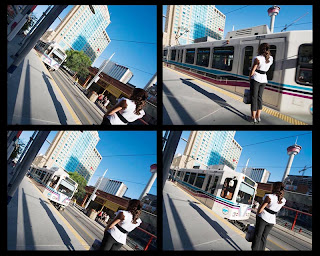
Week 16
The subject is isolated here to draw attention to it. Sometimes what you leave out is as important as what stays in. This technique is frequently used in portraiture and there are several approaches you can use or combine:
1) use a longer lens,
2) control (open) the aperture,
3) simplify the background,
4) and get closer to the subject and further from the background.
I've used all four techniques here. It was wet,
snowy, and windy this morning and generally not nice weather so I wasn't planning on going too far from the apartment. I was watching the snow from the patio when I notice how pathetic the
berry bushes were. When the snow stopped I thought I would try to make a photo of one of the leaves on a bush and after 130 tries this is what I got. I tried different apertures, frames, natural light, a soft box, rimlight and various combinations.
The camera is in aperture priority at f/8 to get the depth of field I wanted - the lens is capable of f/2.8 but I am very close here. In fact, the leaf is not in sharp focus from front to back but I thought it was a good compromise. The lens is a AF-S Micro Nikkor 105mm 1:2.8 G ED VR on the Nikon D3 and I am maybe 50 to 60 cm or so from the leaf. The stucco wall of the apartment is about 1 m behind the leaf. I couldn't get the camera where I wanted it on the tripod, and the wind was blowing the leaf, so I hand held and put the sensor speed at ISO 800 to get a faster shutter. It ended up being at 1/250 second.
Natural light is from the right but is extremely diffuse from the clouds and light snow flurries. To pump up the shot I had a speedlight (SB-600) being controlled from a SB-800 on the camera from behind giving rimlight and putting a glow on the leaf. There is also a small LiteDome XS softbox with another SB-600 (you have to get all your equipment out every once in a while) dialed way down on the left just outside the frame.
Post was more than I normally do... In addition to isolating the leaf and darkening the background I added saturation and contrast to the leaf along with final sharpening.
I like this although it is not one of my better pictures. It tells a story though - it is the last leaf standing when the snow starts to fall. The berries are shriveled and the other leaves have fallen. Soon, it is going to be cold, cold, cold. I use this separation technique fairly often. For example, here is a
fern frond in Australia where the background softened.
Idea based on
In Isolation, pages 48 and 49 in the book
50 Photo Projects, by Lee Frost
 Week 27
Week 27 Week 26
Week 26
























